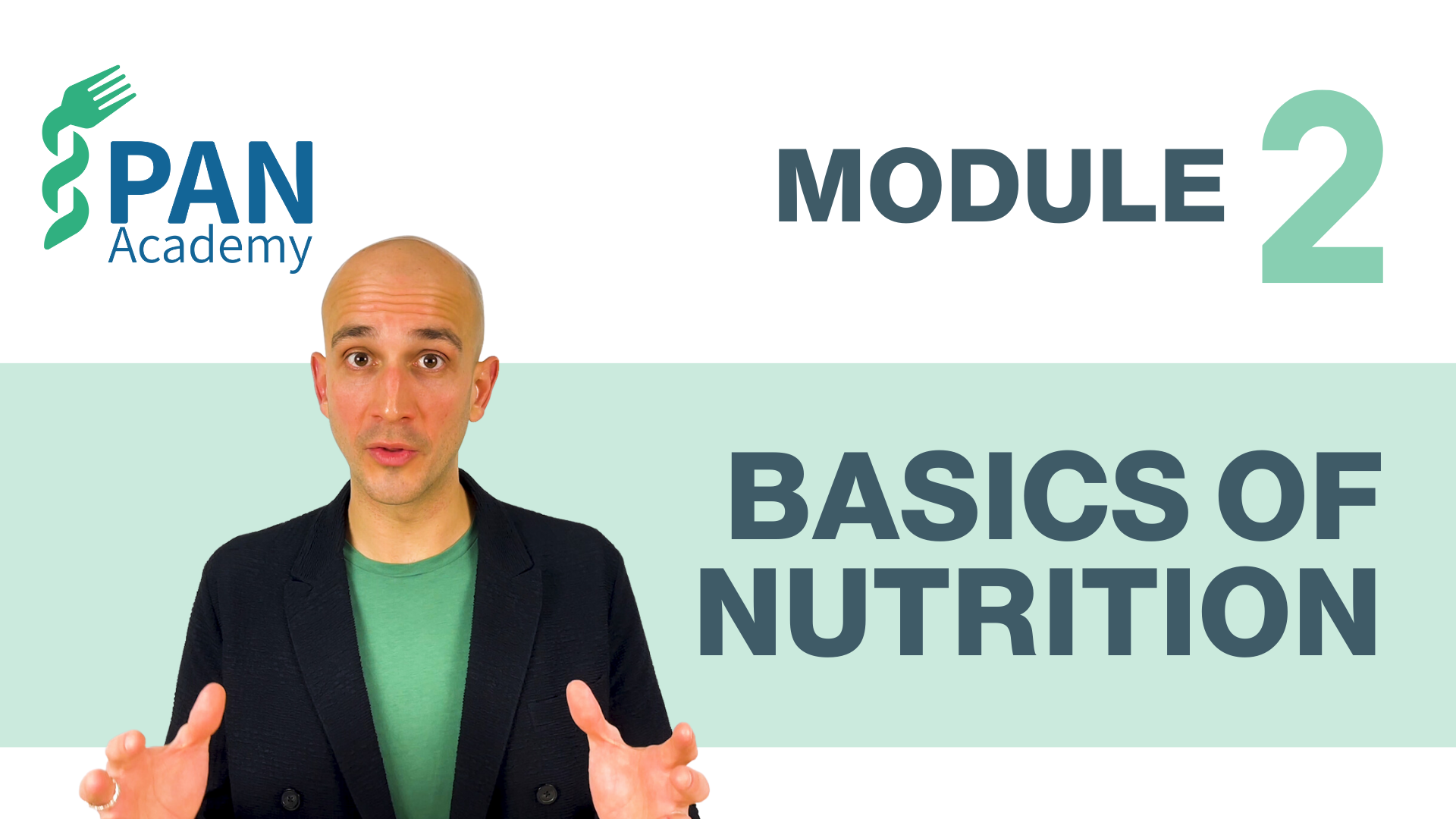
Basics of Nutrition
Module #2 – Introduction
Welcome to the module “Basics of Nutrition”.
In this module, we will provide you with a basic understanding of the compounds that make up our food and talk about their role in health and disease. Take a look back with us at the most important milestones in the history of nutritional science. Let’s explore how our perceptions and challenges related to nutrition have changed over time. In addition, we provide you with useful knowledge and tips for healthy nutrition and dietary patterns.
Learning Objectives
At the end of this module, you will be able to…
- Describe the role of carbohydrates, proteins and fats in our diet
- List the most important milestones in the history of nutritional science
- Discuss some of the common myths and preconceptions about nutrition, deficiencies and the NCD crisis
- Talk about the health-providing properties of selected vitamins, minerals, phytochemicals and fibre
- Give general tips on the best dietary patterns for optimal health
Requirements
- English language
- Basic scientific knowledge
- A medical background is helpful but not essential
- Completion of module #1 “Power of Nutrition” (optional for additional background information)
Target Audience
- Medical students
- Physicians
- Other health professionals
- Nutrition and health enthusiasts
Difficulty Level
- Beginner
Materials Included
- References for further reading
- Cheat sheet PDF (PAN Members only)
- Certificate of completion (PAN Members only)
You are not currently logged in. You need to have a PAN Academy User account or a PAN Membership to view the module content. Please log into your account now. If you do not already have an account, you can create a PAN Academy User account for free here.
Getting Started
The module “Basics of Nutrition” is suitable if you are a nutritional science beginner or if you are an experienced health professional and simply wish to refresh your memory.
➤ Watch the intro video (at the top of this page) to find out what to expect from this module and to take your first trip back in time to where it all began.
➤ Log in as a PAN Member or create a free PAN Academy User account to gain access to the module content.
➤ Each lesson contains a video lesson followed by a quiz so you can test your knowledge and deepen your understanding.
➤ For PAN members only: Get an official certificate of completion and access to a downloadable cheat sheet after completing all lessons, quizzes and successfully passing the final test.
What’s Included?
➤ An introduction video
➤ 7 video lessons
➤ 7 quizzes
➤ 1 summary lesson
➤ Final test (PAN Members only)
For PAN members only:
➤ Take the final test
➤ Download and print your course completion certificate (after successfully passing the final test)
➤ Download the cheat sheet summarising all important information from this module
The Presenter
The module is presented by Cirus Henn who is a nutritional advisor and currently in the last year of his medical studies. He is also a presenter of various PAN seminars and webinars, and the star of our YouTube channel.
The content was researched and created by PAN International’s team of expert nutrition scientists and physicians.
Get your forks and pens ready to start learning about nutrition!
Please note that the video lessons for PAN Academy are short, educative videos (around 10 min) that aim at giving you a brief evidence-based overview of a topic. Therefore, we have to simplify some topics, particularly in our modules suitable for beginners, and we cannot provide you with all the details. If you want to get further insights, please check the material section with references and sources for each lesson.
Example Clips
The clips below are short extracts from the lesson content to give you an idea of what to expect. The full lessons are, on average, 10 minutes in duration or longer. Create an account to watch the full lessons.
Please note that the PAN Academy modules are currently only available in English.
Module #2 Lesson 2 – Christiaan Eijkman and the discovery of vitamins
The work by Dutch doctor Christiaan Eijkman in Batavia (now Djakarta, the capital of Indonesia) was a key milestone in the history of nutrition science.
Module #2 Lesson 3 – Do I need to take Vitamin D supplements?
In this clip, Cirus gives a simple introduction to this complex topic and explains some of the scenarios where vitamin D nutritional supplements might be needed.
Module #2 Lesson 4 – How are dietary recommendations (PRIs) calculated?
Population Reference Intake (PRIs) are values used in public health recommendations for vitamin and mineral intakes. In this clip, Cirus explains how PRIs are calculated.
Module #2 Lesson 6 – Sugar or fat? Which one took the blame for NCDs?
In the 1960s the scientific community attempted to explain the causal factors behind the emergence of a new set of diseases: non-communicable diseases (NCDs).
Sources
Stafford N. History: The changing notion of food. Nature. 468 (2010): 16–17. https://doi.org/10.1038/468S16a
Images:
Antoine-Laurent Lavoisier. Line engraving by Louis Jean Desire Delaistre, after a design by Julien Leopold Boilly. Copyright: Public domain
https://commons.wikimedia.org/wiki/File:Antoine-Laurent_Lavoisier_(by_Louis_Jean_Desire_Delaistre).jpg
Antoine Lavoisier conducting an experiment on respiration in the 1770s. Copyright: Public domain
https://commons.wikimedia.org/wiki/File:Lavoisier_humanexp.jpg
"Hôtel de Ville et Place de Grève (Rathaus und Place de Grève), 1753, Paris, Musée Carnavalet. Copyright: Public domain https://commons.wikimedia.org/wiki/File:Nicolas-Jean-Baptiste_Raguenet,_Place_de_Gr%C3%A8ve.jpg
Liebig's Kali-Apparat. Copyright: Public domain
https://commons.wikimedia.org/wiki/File:Kali-Apparat.jpg
Pettenkofer’s Respirationsapparat, the first human whole-room open-circuit indirect calorimeter. Adopted from: “Lehrbuch der Physiologischen Chemie” by Eugen von Gorup-Besanez (Gorup-Besanez 1867)
https://link.springer.com/article/10.1007/s00421-017-3735-5/figures/2 or http://gorup.heimat.eu/Pettenkofer/Taf-1.gif
Subject emerging from large respiration calorimeter from the Wilbur Olin Atwater Papers, Special Collections, USDA National Agricultural Library. Copyright: Public domain
https://commons.wikimedia.org/wiki/File:Respiration_calorimeter.jpg
Additional Attribution:
Background music in video: https://www.bensound.com/royalty-free-music

